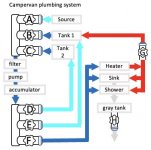TonyM
Forum Member
I'm plumbing the water system for my campervan and made the following schematic to show the different modes it can operate. Although I'm an experienced DIYer, I've never tackled a plumbing job this complicated and I'd appreciate any advice before I actually do this.
Producing a large tank of hot water as needed is (perhaps) a unique feature, and using the pump to draw in water from streams, etc... might also be uncommon.

Normal operation using Tank 1 – B, F open
Normal operation using Tank 2 – C, F open
Filling Tank 1 from a water source – A, E open
Filling Tank 2 from a water source – A, D open
Heating Tank 1 by recycling water through heater – B, F, G open
Emptying all tanks – B, C, F, H open
All valves closed unless specified as open
Additional details: Vents, etc... are not included in the diagram. Tanks 1 & 2 are each 100L fresh water tanks located within the van, and the gray water tank is another 100L tank mounted below the van. The heater is a Truma Diesel heater which heats air in the van, but it also heats a 10L water tank within it. Water sources to fill campers typically are pressurized so there's no need to use a pump to fill them. However, I want to be able to draw water from sources like streams as well. By the way, I don't plan to drink any of this water -- it's just for washing and showering -- but instead plan on bottled water for drinking.
Producing a large tank of hot water as needed is (perhaps) a unique feature, and using the pump to draw in water from streams, etc... might also be uncommon.
Normal operation using Tank 1 – B, F open
Normal operation using Tank 2 – C, F open
Filling Tank 1 from a water source – A, E open
Filling Tank 2 from a water source – A, D open
Heating Tank 1 by recycling water through heater – B, F, G open
Emptying all tanks – B, C, F, H open
All valves closed unless specified as open
Additional details: Vents, etc... are not included in the diagram. Tanks 1 & 2 are each 100L fresh water tanks located within the van, and the gray water tank is another 100L tank mounted below the van. The heater is a Truma Diesel heater which heats air in the van, but it also heats a 10L water tank within it. Water sources to fill campers typically are pressurized so there's no need to use a pump to fill them. However, I want to be able to draw water from sources like streams as well. By the way, I don't plan to drink any of this water -- it's just for washing and showering -- but instead plan on bottled water for drinking.
Attachments
Last edited:

